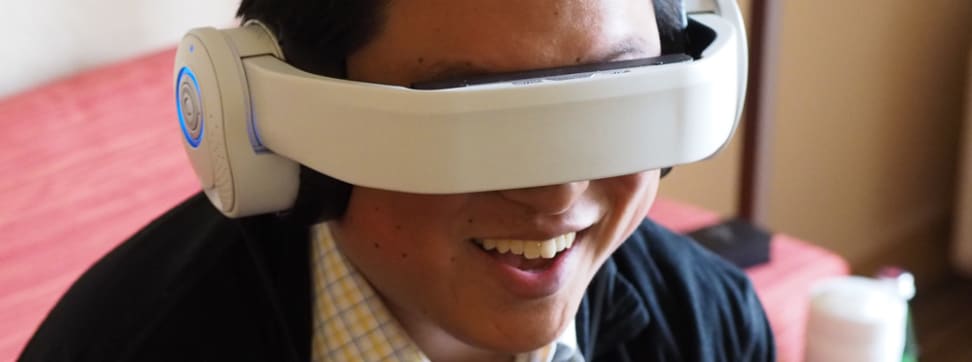 Credit:
Credit:
Products are chosen independently by our editors. Purchases made through our links may earn us a commission.
Avegant’s Glyph is a virtual retinal display that’s making waves at CES 2014. We were fortunate enough to get some hands-on time with the Glyph and meet the team behind this VR wearable.
{{brightcove '3032478667001'}}
First Impressions
It’s important to note that the Avegant team didn’t design the Glyph to directly compete with the Occulus Rift or the Sony HMZ-T3Q. Instead of being designed for fully-immersive VR, the Glyph aims to be a portable 3D device, which can be used with a tablet or smartphone. It has a 40 degree field of view, which allows the wearer to retain awareness of their environment. Glyph is designed to be used on planes, trains and automobiles. You can stream video, play games, listen to music, browse your email or send text images by using the virtual display.
Adjusting the image for optimal viewing requires a bit of tweaking. There are two separate rotating dials that adjust interpupillary distance (IPD), as well as individual focus controls for each of the optics. This allows users with a variety of eye prescriptions to use the device without needing to wear glasses, which is unique among current VR wearables. Once you find settings you like, you can lock them in place by pressing a button.
By projecting an image directly into your eyes (using TI’s digital micromirror technology and a low-powered LED), the Glyph’s VRD essentially uses the back of your retina for a display surface. Since this mimics natural light reflection (i.e. staring at a real object vs. staring at a screen), you won’t experience screen fatigue during long periods of viewing. Another advantage of the VRD component is its low power consumption and lightweight hardware.
Right now, the Glyph streams video via a MLH or HDMI cable. Since it’s a plug-and-play device, it doesn’t require any special drivers or software in order to operate. It already works with existing content, which gives it a consumer-friendly advantage over some other VR devices.
Image Quality
As far as clarity, there is definitely a "wow factor" when you first experience the image projected by the Glyph. It’s quite amazing to realize that you aren’t staring at a screen, and that the projected image is reflecting off the back of your retina. Since it projects into each eye independently, you can view images and video in full 3-D.
We watched samples from two videos during our demo–an ocean documentary, and Life of Pi. Both of them were displayed in crisp, crystal-clear quality without any visible pixilation. The colors were extremely vivid, and both videos required no additional adjustments for optimal 3D viewing. After that we experimented with listening to music, browsing email, playing a mobile racing game and sending text messages through a connected iPhone. There was no visible lag, and text was displayed with the same crystal-clear quality as the demo video.
Design Elements
{{ gallery "gallery" }}
Admittedly, the "human" element of Avegant’s Glyph is still being developed. While the cushioned headphones are comfortable, switching to video mode (flipping down the visor) means the device needs to rest on your nose, which is a bit unwieldy for a 1.3lb device. The headphones also have a bit of trouble clinging to your head in video mode. However, considering that the next model of the Glyph that will be part of Avegant’s Kickstarter campaign will weigh less than a pound, there’s still room for these issues to be resolved.
Future Developments
The development team plans to incorporate head tracking, reduce the weight of the device and possibly add a head strap for additional support. Avegant is launching a Kickstarter on January 22, where the Glyph will be available for $499.
